21 wet room ideas to add a sense of luxury to your bathroom
Elevate your bathroom design with these stylish wet room ideas

Jennifer Ebert
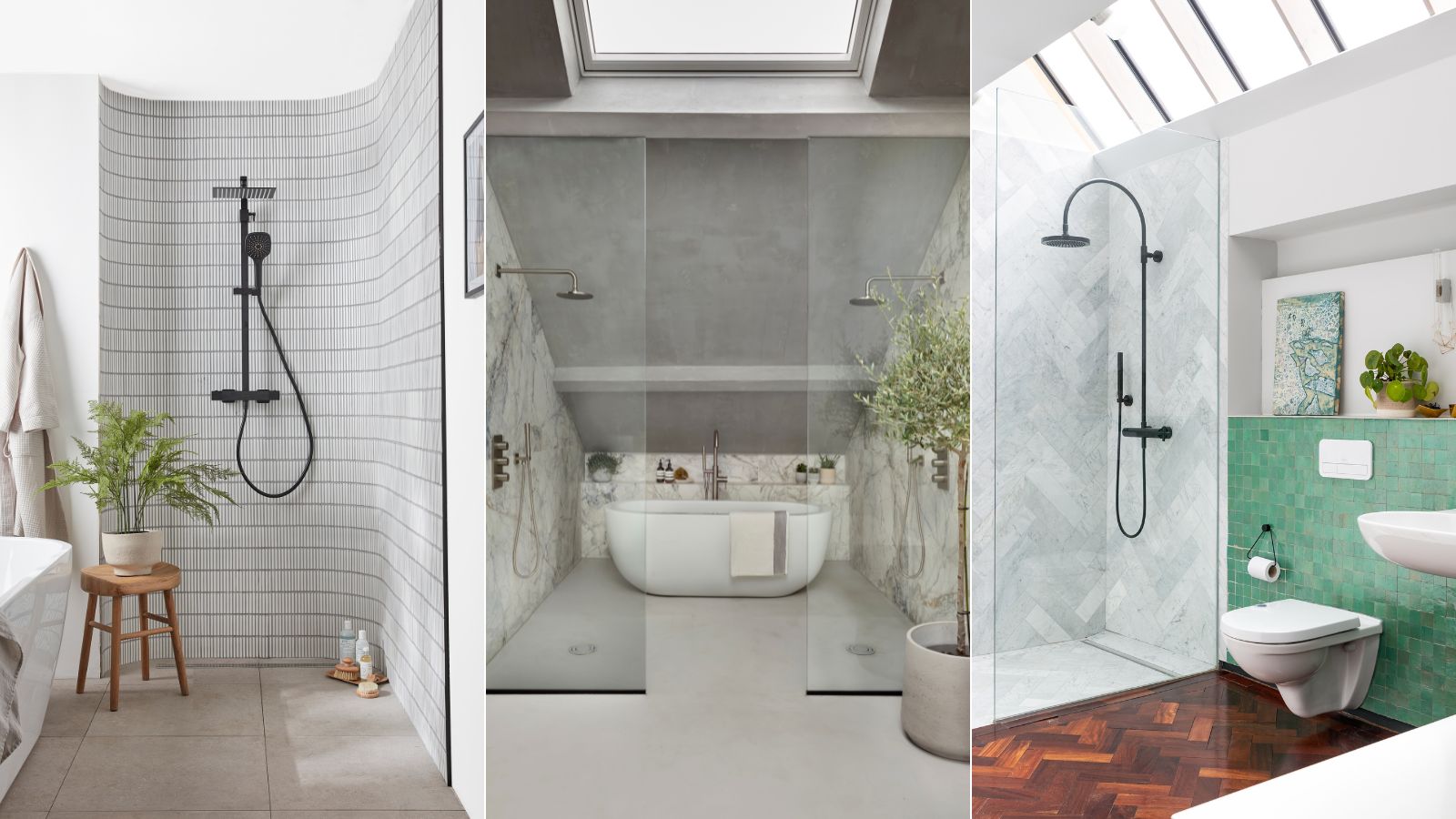
- 1. Hide the pipework
- 2. Opt for a flush floor
- 3. Introduce a wet room to a large bathroom
- 4. Introduce contrasting colors and finishes
- 5. Use light, natural materials in a small wet room
- 6. Save space with a cloakroom basin
- 7. Opt for porcelain tiles
- 8. Add Scandi-style with wood paneling
- 9. Create a fluid design to give the illusion of more space
- 10. Choose a screen that matches your existing hardware
- 11. Ensure the space you intend to use is fully tanked
- 12. Consider underfloor heating to keep the space dry
- 13. Consider different surfaces ideas, not just tiles
- 14. Pick the right sanitaryware
- 15. Design a wet room around an awkward space
- 16. Create the illusion of a wet room in a standard bathroom
- 17. Add interest with patterned tiles
- 18. Choose the right tile size
- 19. Create a spa-like sanctuary
- 20. Integrate a built-in seat in a wet room
- 21. Make sure there is sufficient lighting in your wetroom
- FAQS
If you want to create a luxurious bathroom, wet room ideas will be right up your alley. Perfect for spaces small and large, the seamless flow between the shower and your other bathroom amenities makes mornings functional and stylish.
It’s also great for anyone who wants to stray from traditional bathroom ideas – wet rooms offer a great range of designs that might not be possible in other layouts. Whether you want to make the most of a small room or create a sense of tranquility in a sprawling scheme, wet rooms offer something a little bit different.
From tile designs and zoning to color and materials, these wet room ideas come highly rated by interior designers and bathroom experts – and prove how endlessly stylish this setup can be.
21 wet room ideas for a luxurious design
Wet rooms are more versatile than you might think, and they can add a real sense of luxury to your home. And, where space permits, you can still have a bath if that’s essential for you.
‘Wet rooms are fast becoming a favorite of bathroom designers, offering the opportunity to create sleek and minimalist spaces that are both practical and aesthetically pleasing. Luxury designers are embracing wet rooms to design a smaller bathroom without compromising on quality,' says Mike Whitfield, luxury interiors expert at LUSSO.
Whether you’re still on the fence about whether a wet room is right for you or you simply need inspiration to bring your space to life, these wet room ideas offer something for every style and space.
1. Hide the pipework
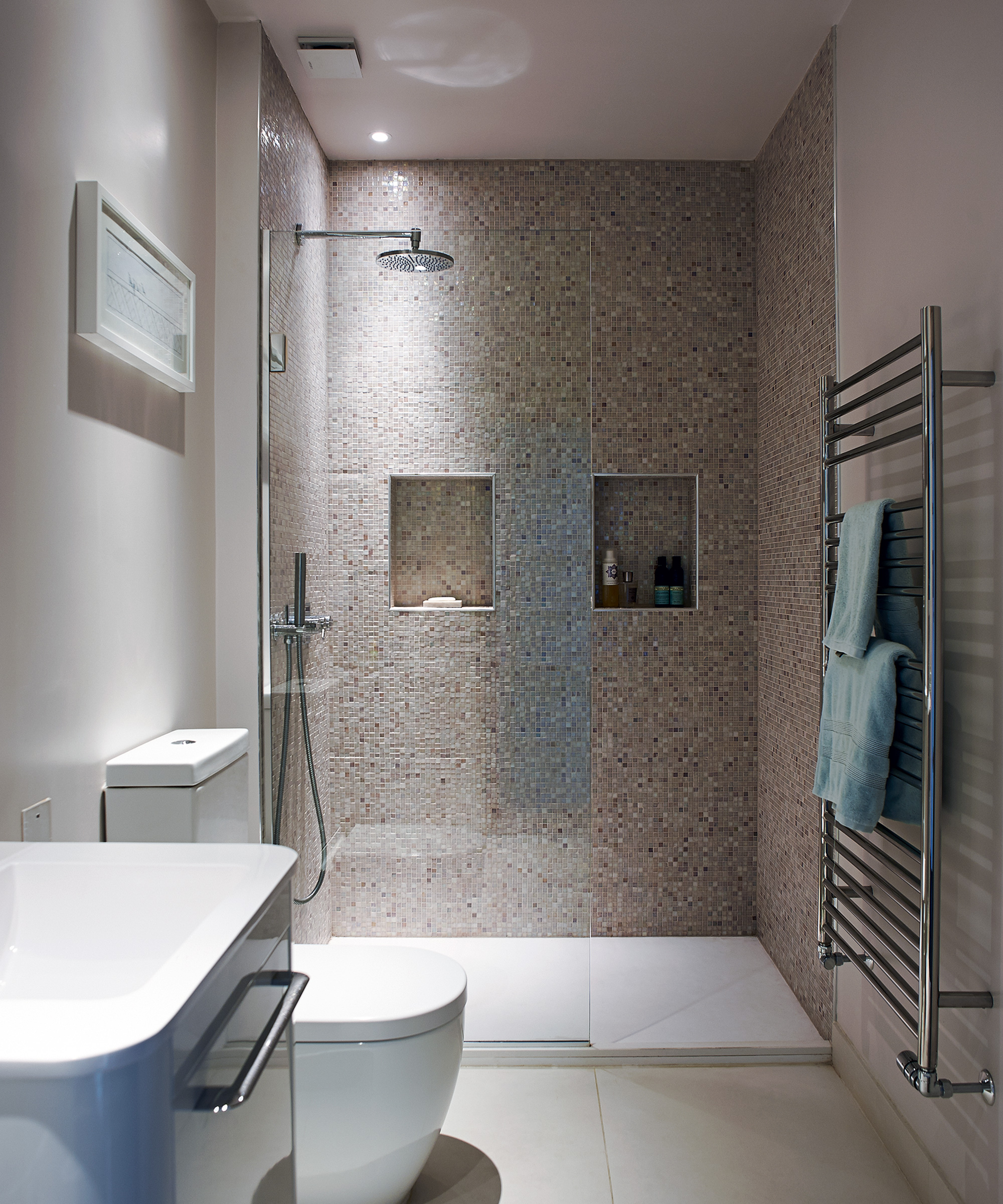
To create a seamless and chic wet room design, attention to detail is key. In particular, making sure any pipework or unsightly hardware is hidden will make a huge difference to the overall look and feel of the finished space.
Design expertise in your inbox – from inspiring decorating ideas and beautiful celebrity homes to practical gardening advice and shopping round-ups.
‘The secret to a good wet room is to have all of the mechanics hidden away, like the pipework for the shower and discrete drainage in the floor,’ says Grazzie Wilson, head of creative at Ca’ Pietra.
While this is a more practical element to think about, it’s also important for aesthetics, so taking the time to find ways of hiding the less pretty elements is a worthy cause – and one you’ll thank yourself for in the end.
2. Opt for a flush floor
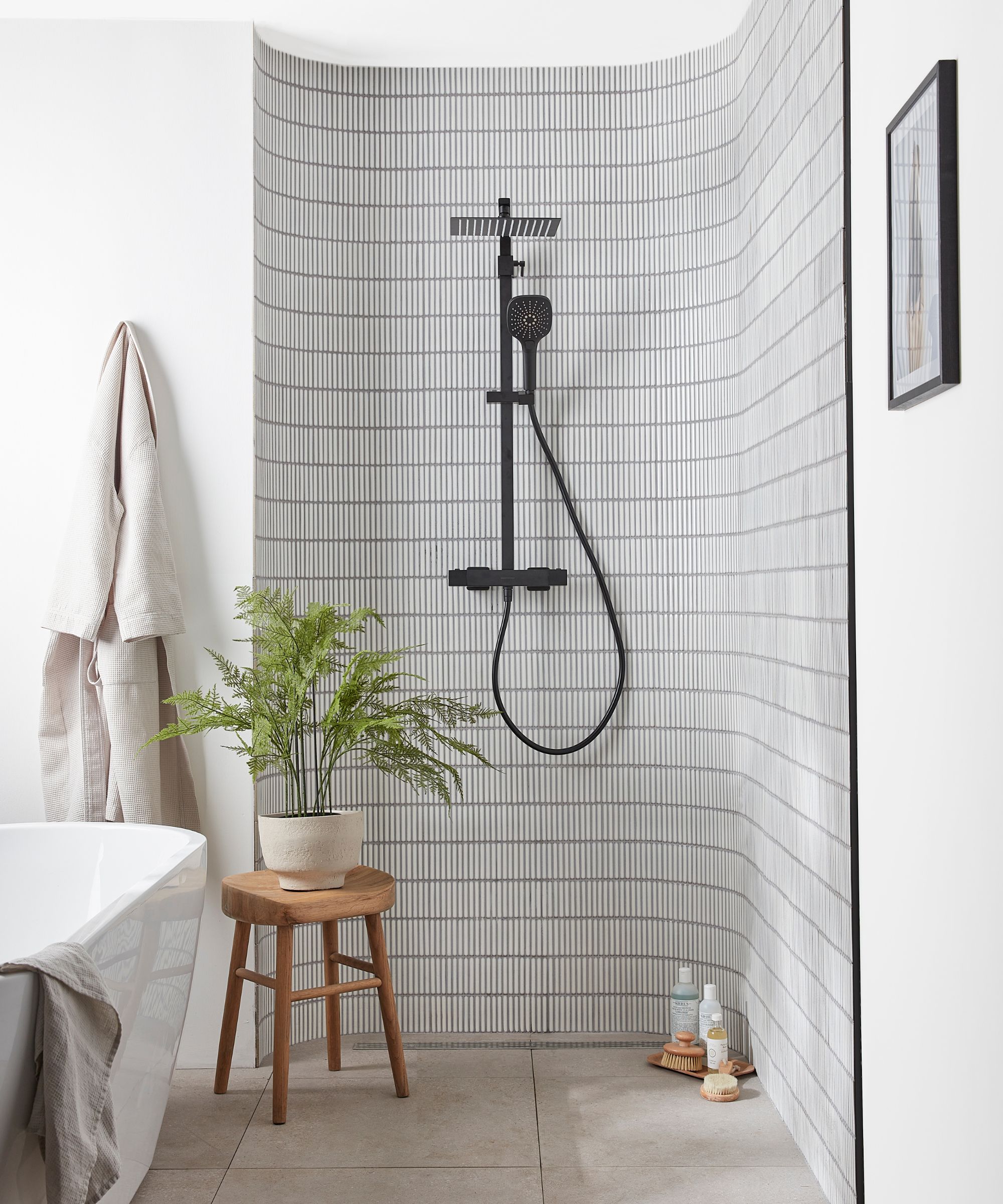
Regular showers feature a shower tray or vase with a lip – it keeps the water in and creates a separate zone. But in a wet room, opt for a design that sits flush with the floor tiles for a sleek finish.
‘A flush floor throughout is a must, so go for a shower tray that’s either low level and sits flush with the tiles or, even better, a hidden tray system where your chosen tiles are laid on top – we know it’s the tiles that are the real star,’ says Grazzie.
It might seem like a minor detail, but it will make a huge difference to the final look of your wet room – and you’ll probably find it much more seamless when you’re getting in and out of the shower, too.
3. Introduce a wet room to a large bathroom
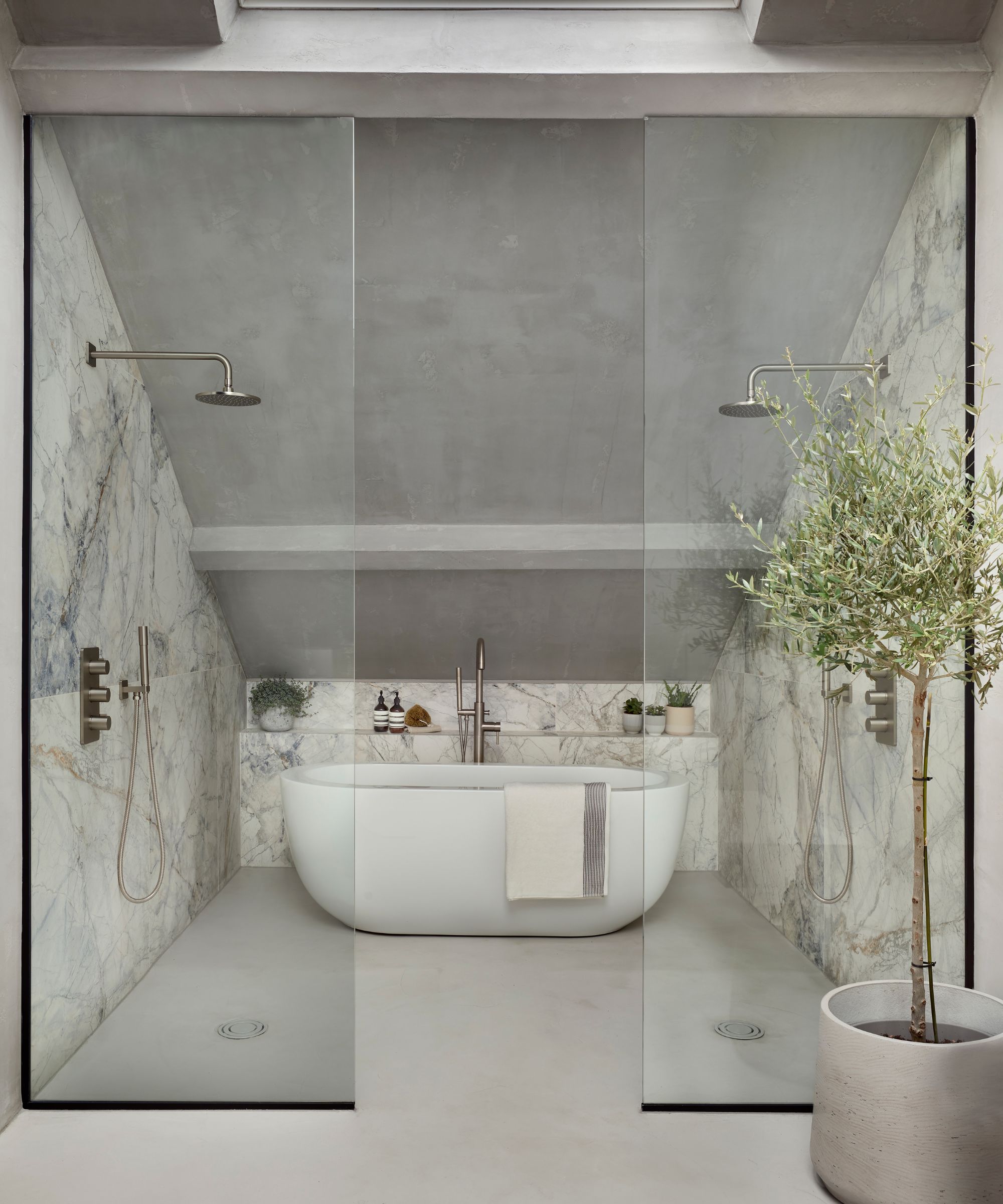
It’s a common misconception that wet rooms are better for small bathrooms, and while they do maximize a bijou space, they work just as well in a large one too.
‘Wet rooms don’t have to be limited to small bathrooms, chosen because they can save space. Wet rooms can work as part of a much larger bathroom, often becoming part of the main features or focal points,’ says Barrie Cutchie, design director at BC Designs.
‘To do this successfully, consider how to make the wet room area really pop, whether you use it to frame a freestanding bath or if you choose to double up – after all, why have one wet room area/shower when if space allows, you can double up.’
4. Introduce contrasting colors and finishes
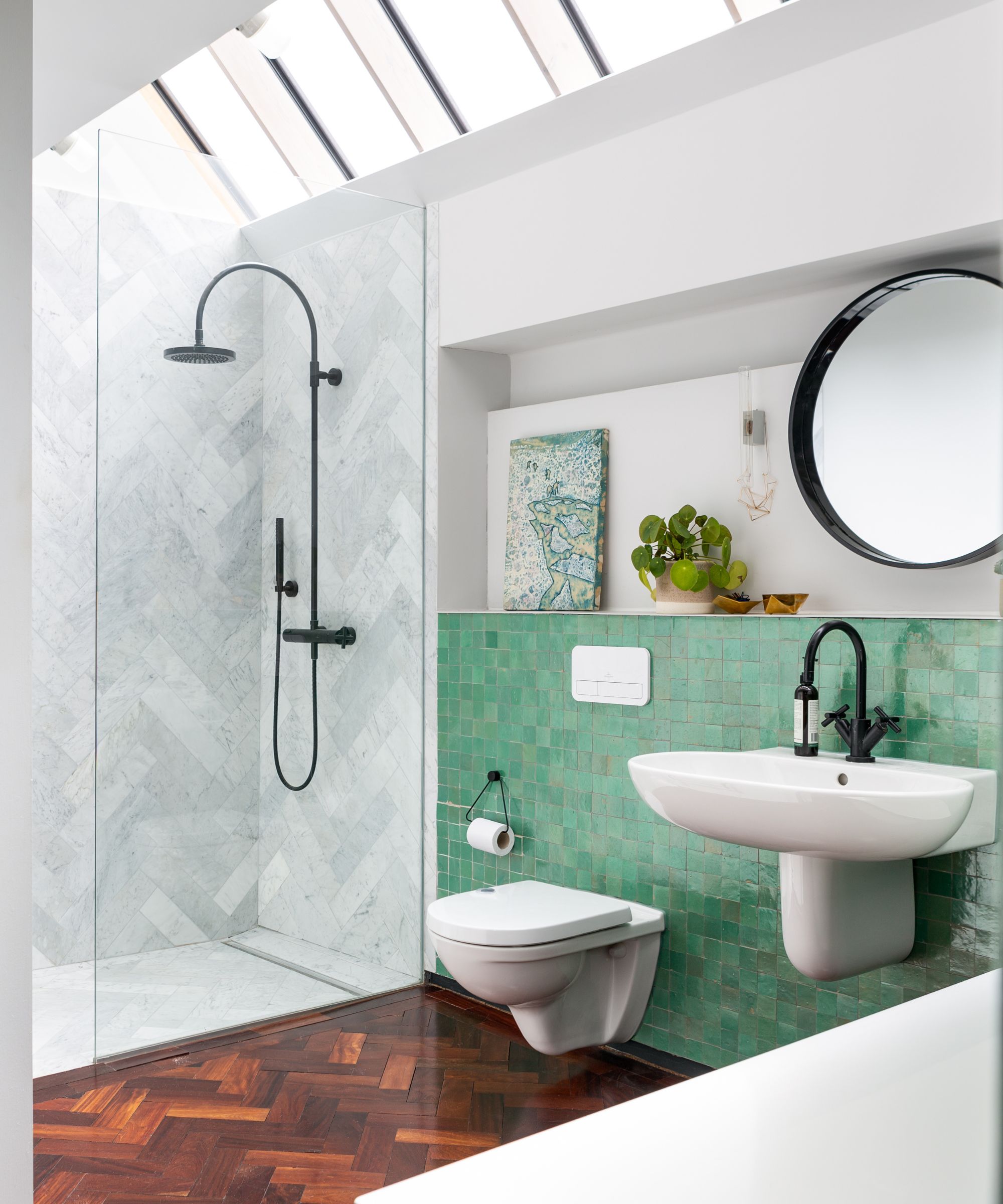
In a room filled with consistent tiles, you’ll want to add contrast to the space for visual interest. And the best way to do this is with statement hardware.
‘Create a serene wet room by sticking to a cohesive palette of soft neutrals, accented with darker tapware or brushed metal fixtures for contrast,’ suggests Sophie Goldhill, co-founder at Liddicoat & Goldhill and Hector Interiors.
‘Incorporate a statement element, such as a textured tile wall, to add visual interest. Enhance the relaxing ambiance with soft, diffused lighting, and make the most of natural light to bring in a sense of luxury,’ she adds.
5. Use light, natural materials in a small wet room
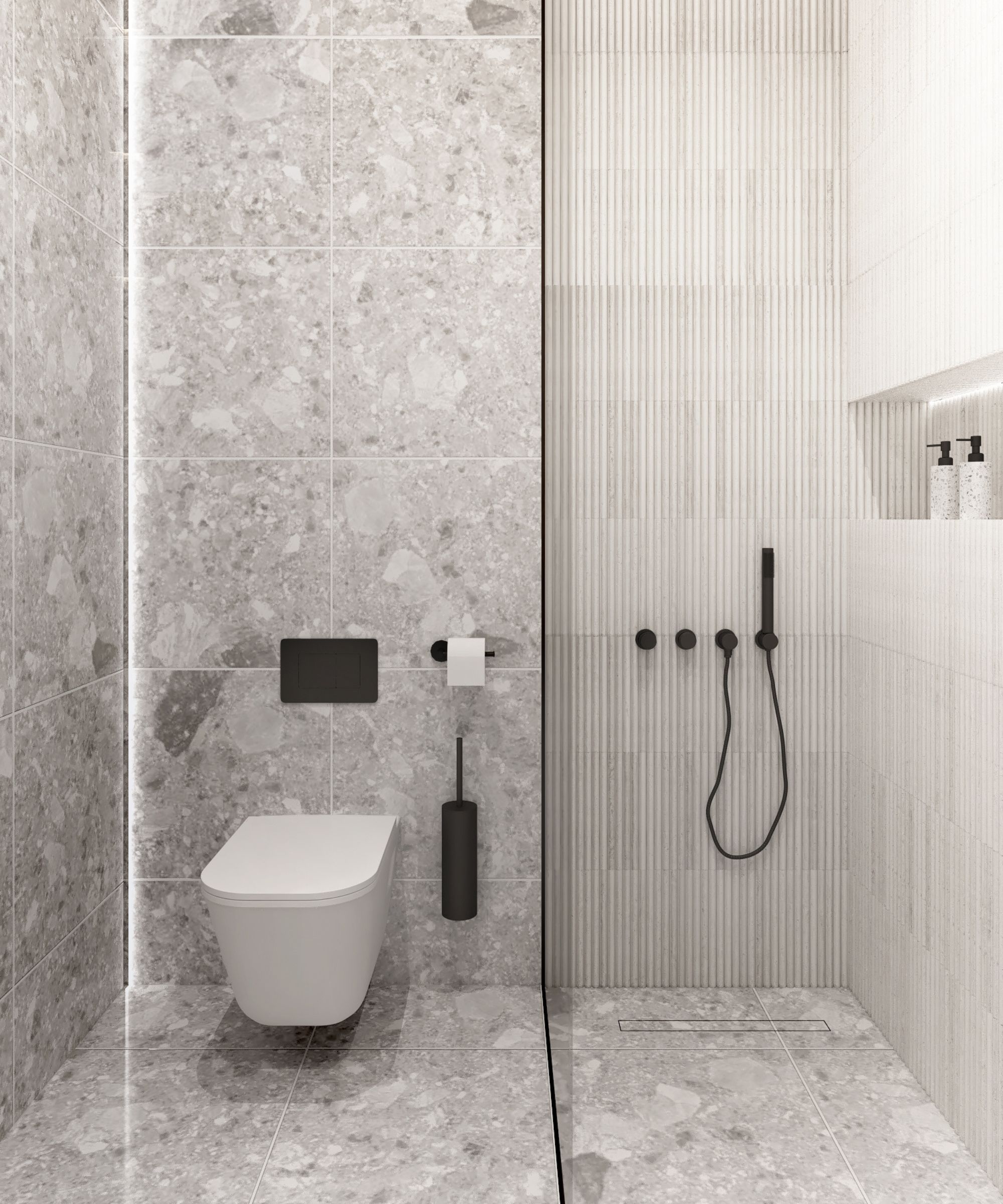
For a sense of serenity and tranquility in a small wet room, opt for light tones and natural materials that offer a sense of openness.
‘A LUSSO favorite that epitomizes luxury is to incorporate marble or natural stone tiling throughout the room. Natural finishes help to make a smaller space feel light and airy, as well as provide a luxurious feel that puts us in touch with the healing properties of nature,’ says Mike.
‘A shower unit can be blended into its natural surroundings by installing a stone shower tray that fits with the color and styling of your choice of tiles,’ he explains.
6. Save space with a cloakroom basin
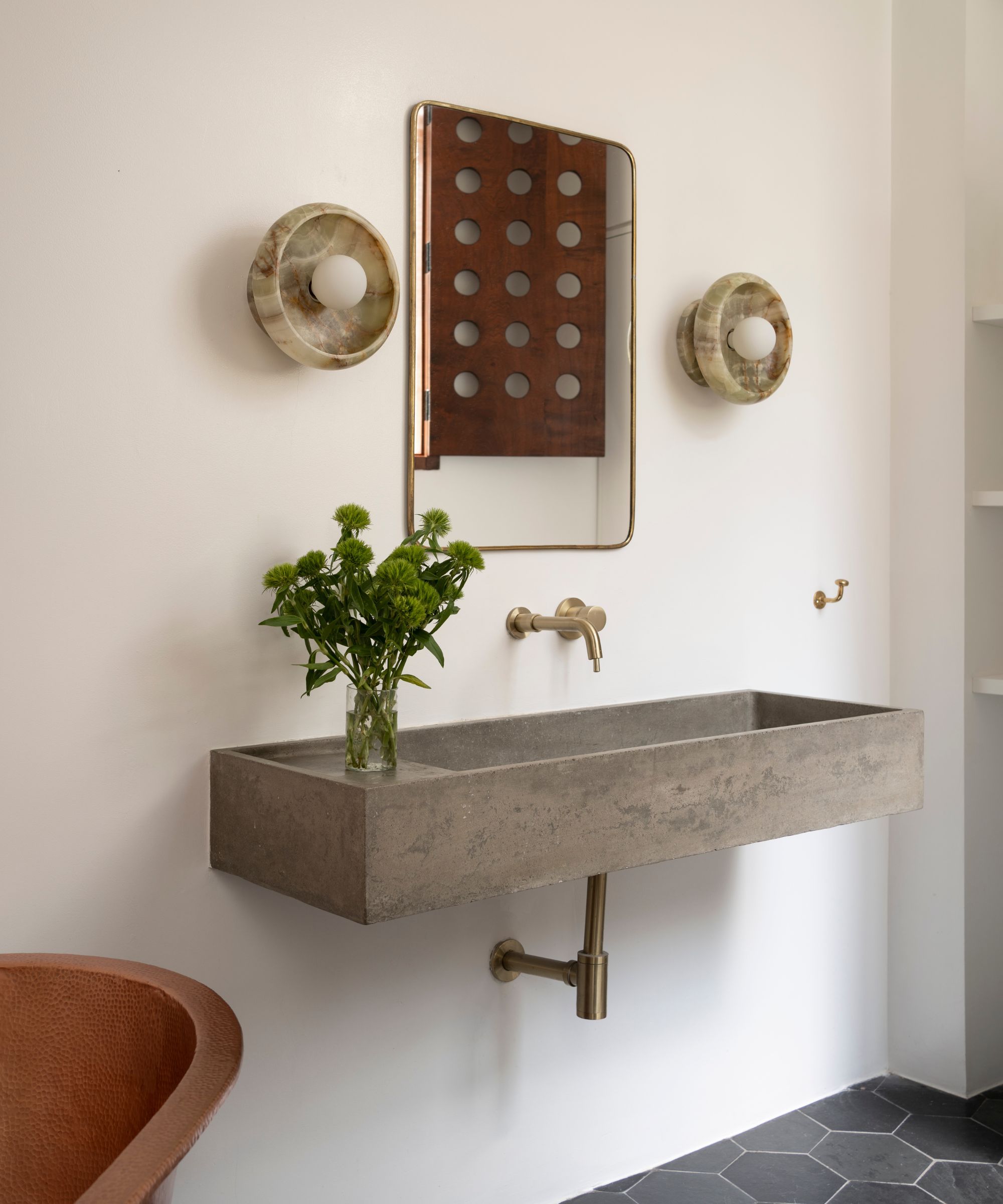
Sometimes you need a smaller sink basin in a wet room, especially if you’re restricted on space. Instead, choose a smaller model that you might usually expect to find in a small en suite or cloakroom.
‘Space-saving fittings like cloakroom basins help to prevent a smaller space from feeling crowded, whilst also providing the luxury finishing touches to complete your wet room,’ says Mike.
You can still go for something luxurious, statement, or bold to suit your interior design style, but introducing something that little bit smaller can help your scheme feel more cohesive rather than overcrowded.
7. Opt for porcelain tiles
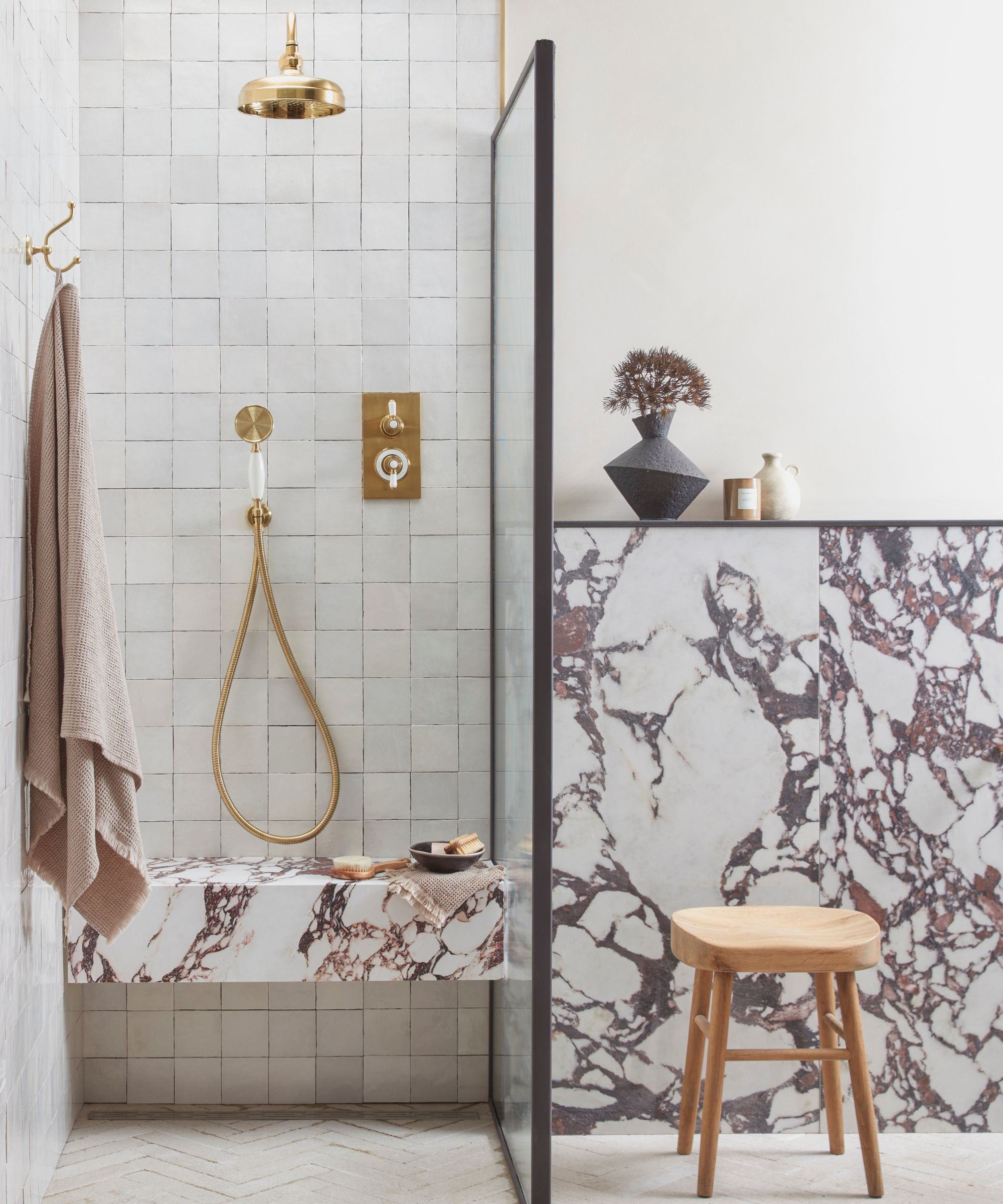
In a wet room, tiles are one of the main features – practically and aesthetically. So, choosing something that is durable enough while also looking beautiful is key to a successful design.
'When it comes to tile choice, porcelain is a winner. It’s impervious to water, works for the walls and floors (check the slip resistance for the floor for safety. We advise an R rating of R11 for wet rooms) and is easy to keep clean,' says Grazzie.
Porcelain tiles offer the perfect balance of hard-wearing and visually appealing, but the style of tile you choose will really depend on your lifestyle and how much cleaning and upkeep you want to do.
'Think about the size of your tiles and how many grout lines there will be. The fewer grout lines, the easier the maintenance. Having said that, if you’re not worried about a bit of elbow grease, mosaics are a top choice too as they provide good slip resistance and can pack a style punch,' she adds.
8. Add Scandi-style with wood paneling
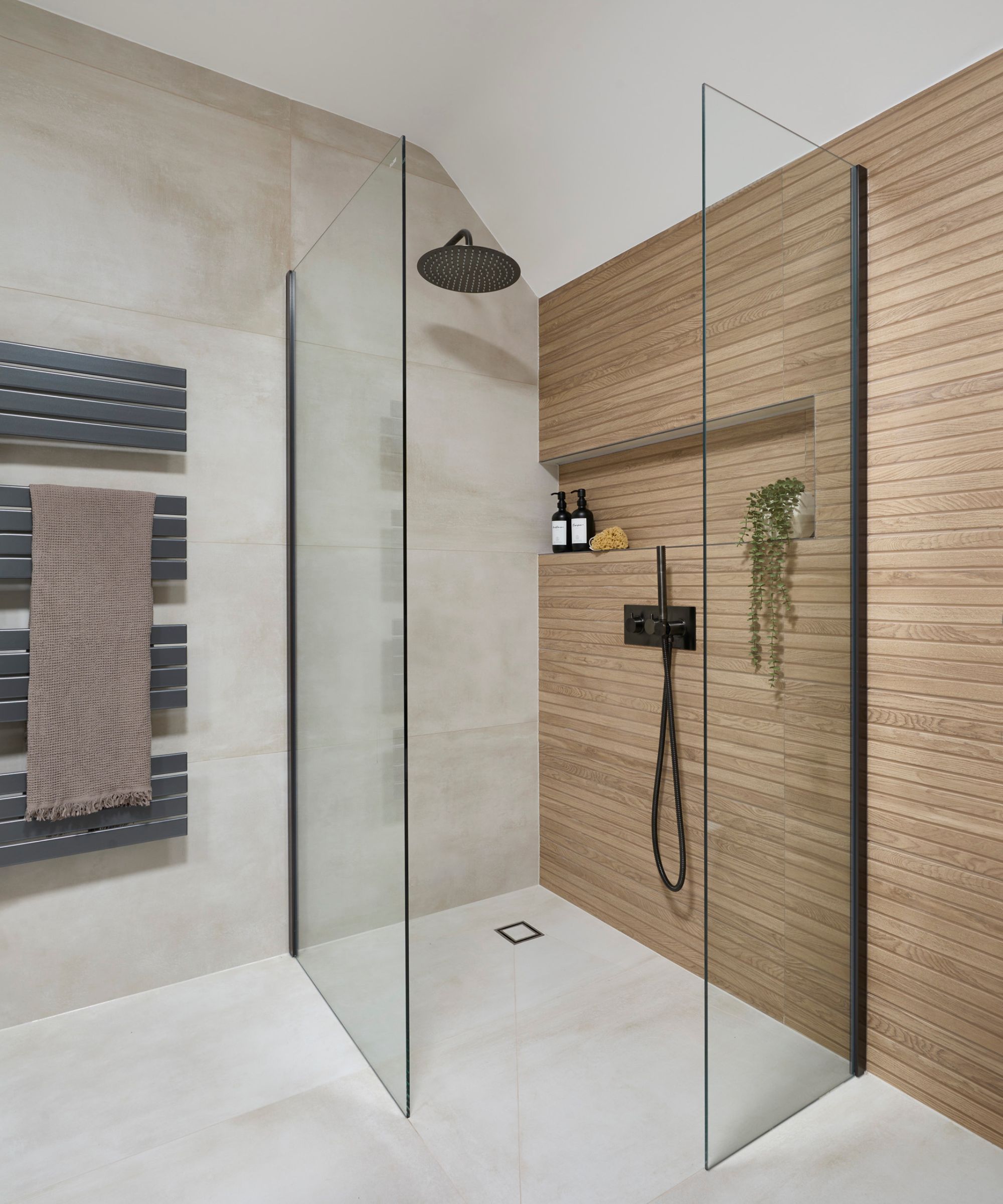
As with any bathroom design, the decor style you choose will have a huge impact on the overall look and feel of the space. For most of us, creating a space that feels tranquil and luxurious is key for a serene wet room, so embracing a Scandi-style scheme is a great choice.
In this wet room, a feature wall had been created using horizontal wood paneling. As well as giving the illusion of a larger space, the wood detail brings in the Scandi decor style that is synonymous with tranquility and pared-back luxury.
Introducing the paneling has also made it possible to create a shower niche recessed into the wall, offering a seamless design feature that's perfect for essentials to be stored.
9. Create a fluid design to give the illusion of more space

There's a reason why wet rooms are so popular in smaller bathrooms. For one, they take up a lot less room than the traditional bathroom layout, but they can also make the space look much bigger with the right design.
'Wet rooms provide a seamless design. You’d typically not have a differentiation between the shower space and the rest of the bathroom, so you won’t have an obvious zone compared to other shower choices,' says Louise Ashdown, head of design at West One Bathrooms.
While zones are typically preferred in interior design, a wet room is often the exception to the rule. 'There are positives in choosing this route, including helping smaller bathrooms to seem larger,' she adds.
10. Choose a screen that matches your existing hardware
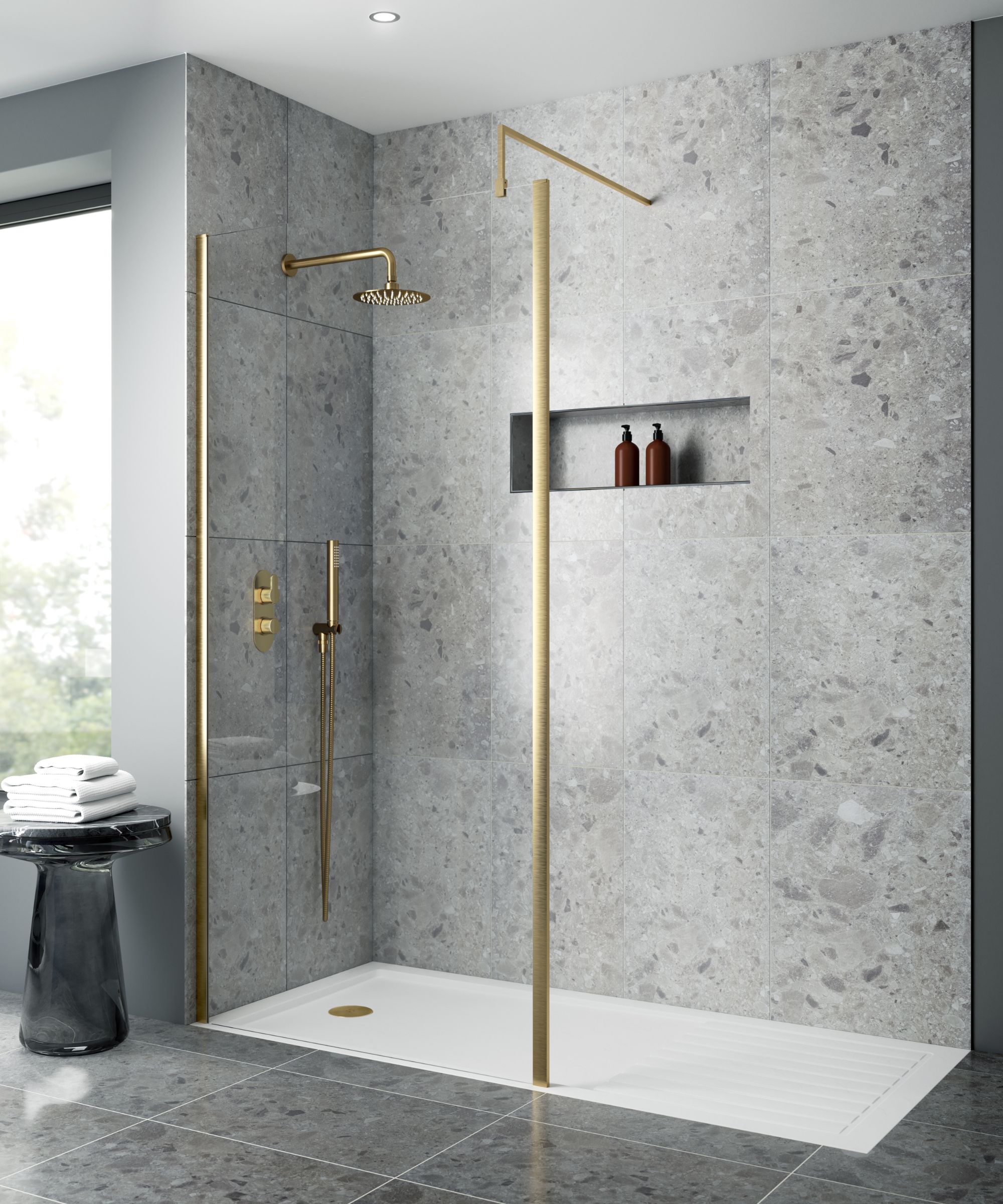
In a regular bathroom, the shower screen might be a feature you overlook, or perhaps don't put as much thought into as other features within the space. But in a wet room, the screen becomes a key feature, and the only thing that creates a divide within the scheme.
'Many homeowners are looking for low maintenance wet room items which is why having features that are easy to clean is an essential,' says Colm Lalor, commercial director at nuie. Choose something without too many nooks or crevices so it's easy to clean and doesn't create too much of a visual divide in your wet room.
To make it feel more elevated, ensure any hardware features on the screen match the colors and finishes used elsewhere in your wet room. 'Finishes are key today, so choosing a frame finish that matches perfectly with your brassware helps,' adds Nicholas Cunild, managing director at Matki.
11. Ensure the space you intend to use is fully tanked
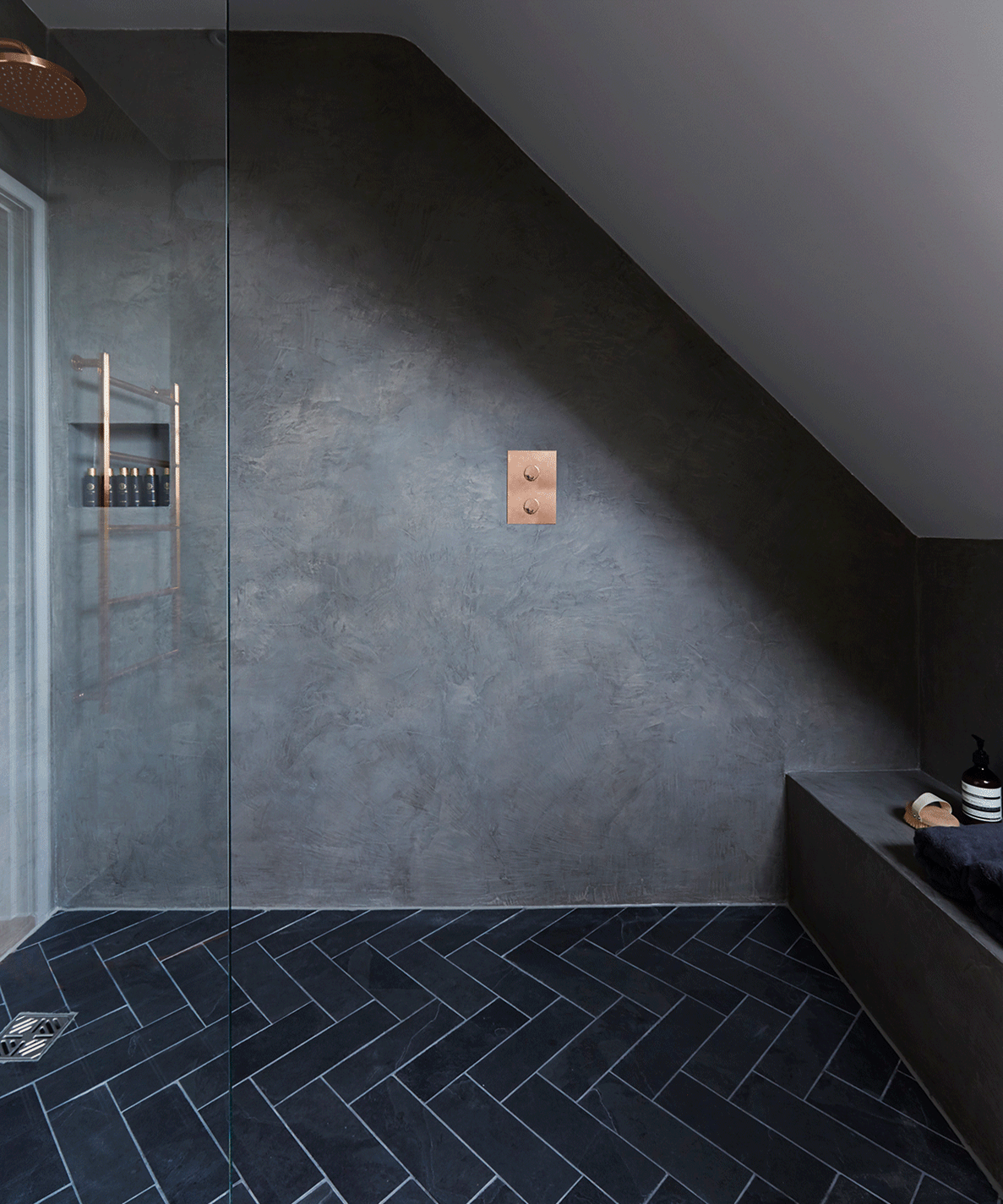
It goes without saying that a wet room needs to be waterproof. Luckily builders are a lot savvier about how to achieve fully tanked spaces nowadays and wet room tanking systems and products are readily available.
'In particular, hidden tray systems, which fit under the floor tiles and take care of drainage gradients and water-tightness have proved a real game-changer,' says Nicholas.
'Low-level shower trays that fit flush with the tiles are also popular and can help define the shower room in a bigger room. Wet room installation is not for novices, it’s important to find a tanking specialist or builder with verifiable experience,' he adds.
12. Consider underfloor heating to keep the space dry
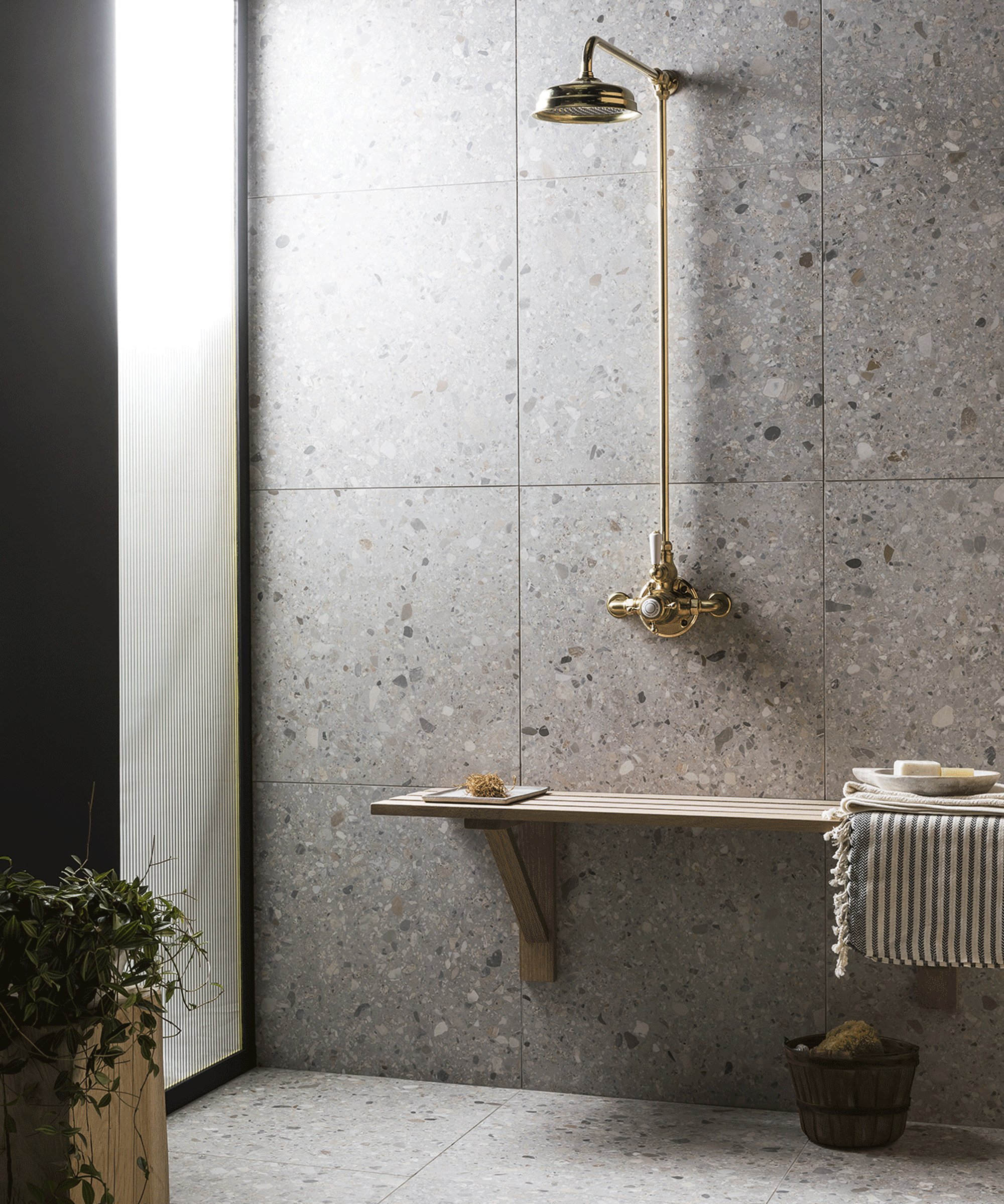
While aesthetics are crucial to wet room ideas, so are the more practical elements. Wet rooms and bathrooms are typically colder rooms in the come thanks to the more utilitarian materials, so any way to make your scheme warmer will be welcomed.
'It’s important to take extra steps with regards to heat, ventilation and drying than you would in a regular bathroom. You may be lucky enough to live in a hot climate which naturally gives a warmer bathroom. But if you live in a colder climate and you exit a wet room onto carpeted rooms – add kids, dogs and all the rest – it is a recipe for waterlogged, messy floors everywhere,' says Nicholas.
'A screen will help contain major puddles, but underfloor heating and heated towel rails will also speed up the drying process and help prevent slip hazards. Mechanical ventilation is a must and will help clear steam quickly – look for models with intelligent humidity sensors that automatically boost when required.' You can also pair this with a beautiful, easy-to-wash bathroom rug.
13. Consider different surfaces ideas, not just tiles
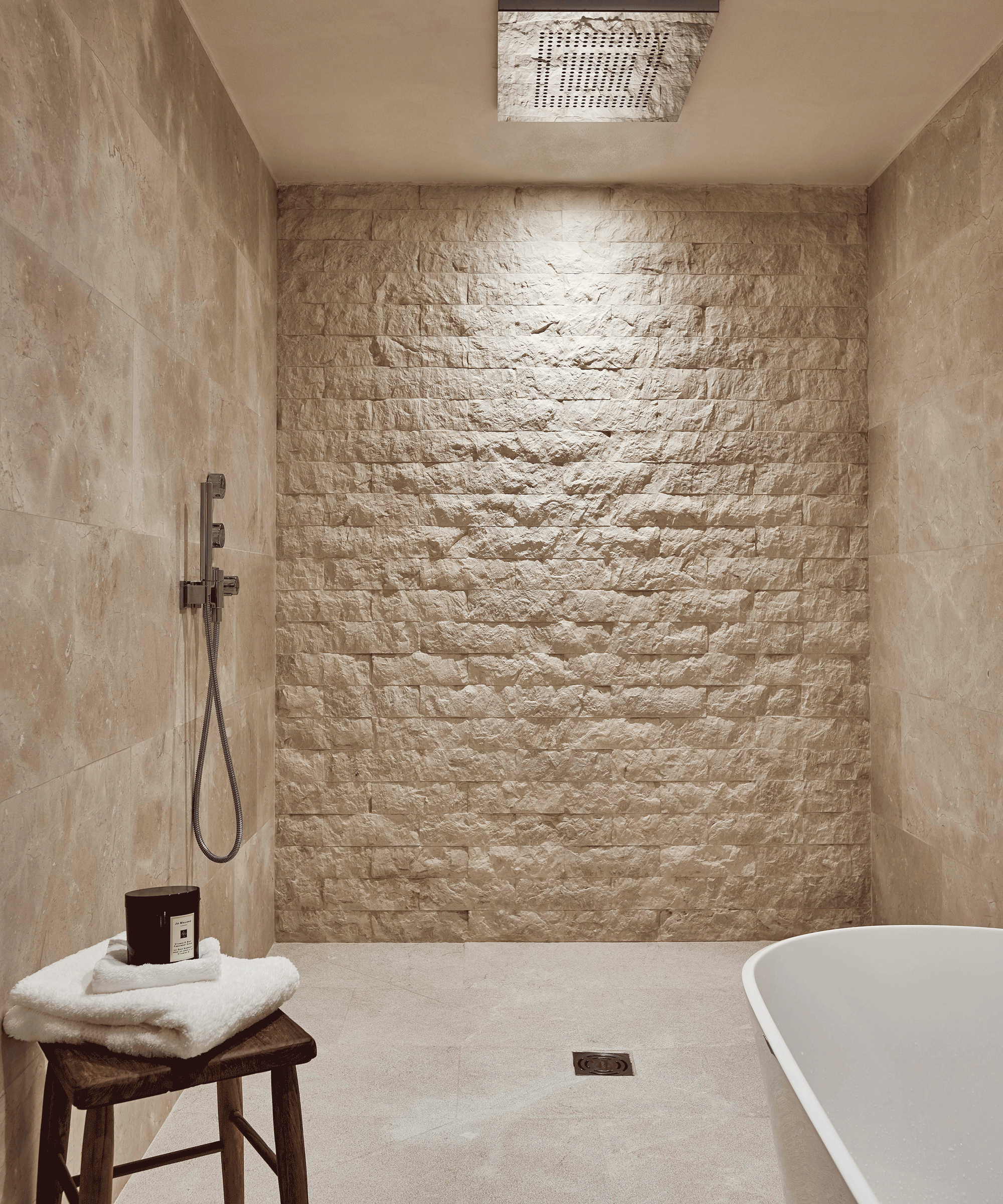
Tiling from floor to ceiling is practical but can feel cold and uninviting in large volumes, especially if you prefer a neutral scheme. Nicholas points out the importance of exploiting other options.
'We’ve noted a rise in polished plaster – both traditional Tadelakt and more modern Microcement – in wet room designs and the results are stunning,' he says.
Built up in layers, the finish is waterproof and seamless, so there’s no grubby grout to tackle. The color of the plaster in this wet room adds instant warmth to the space, and creates a fun, cave-like feel.
14. Pick the right sanitaryware
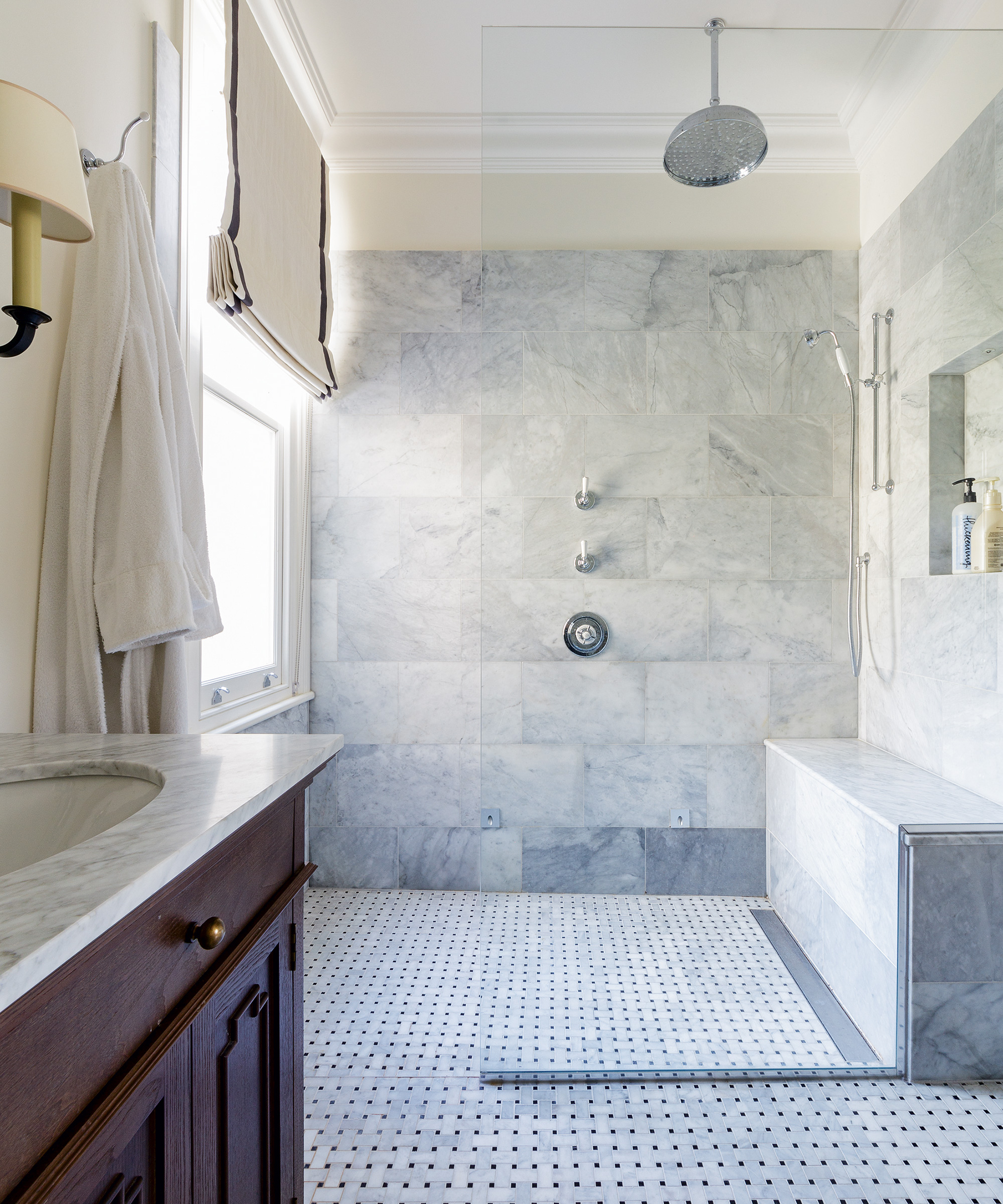
A wet room is more than just a shower – you also need to carefully consider the other features, from the vanity to the toilet itself. While you'll definitely want to introduce stylish pieces, it's also important to factor in the more practical features, too.
'If you are embracing the full wet room in a large bathroom look and omitting any sort of enclosure or screen, it is fundamental to think about your choice of sanitaryware, as it is likely that it will get wet from the spray of the shower or the condensation in the room,' advises Rebecca Milnes, designer at CP Hart.
'Opt for ceramics that are flush to the wall and are ideally wall-mounted. A wall-hung toilet is a brilliant choice in a wet room, as there are no areas for water to pool and it makes cleaning easier,' she advises.
15. Design a wet room around an awkward space
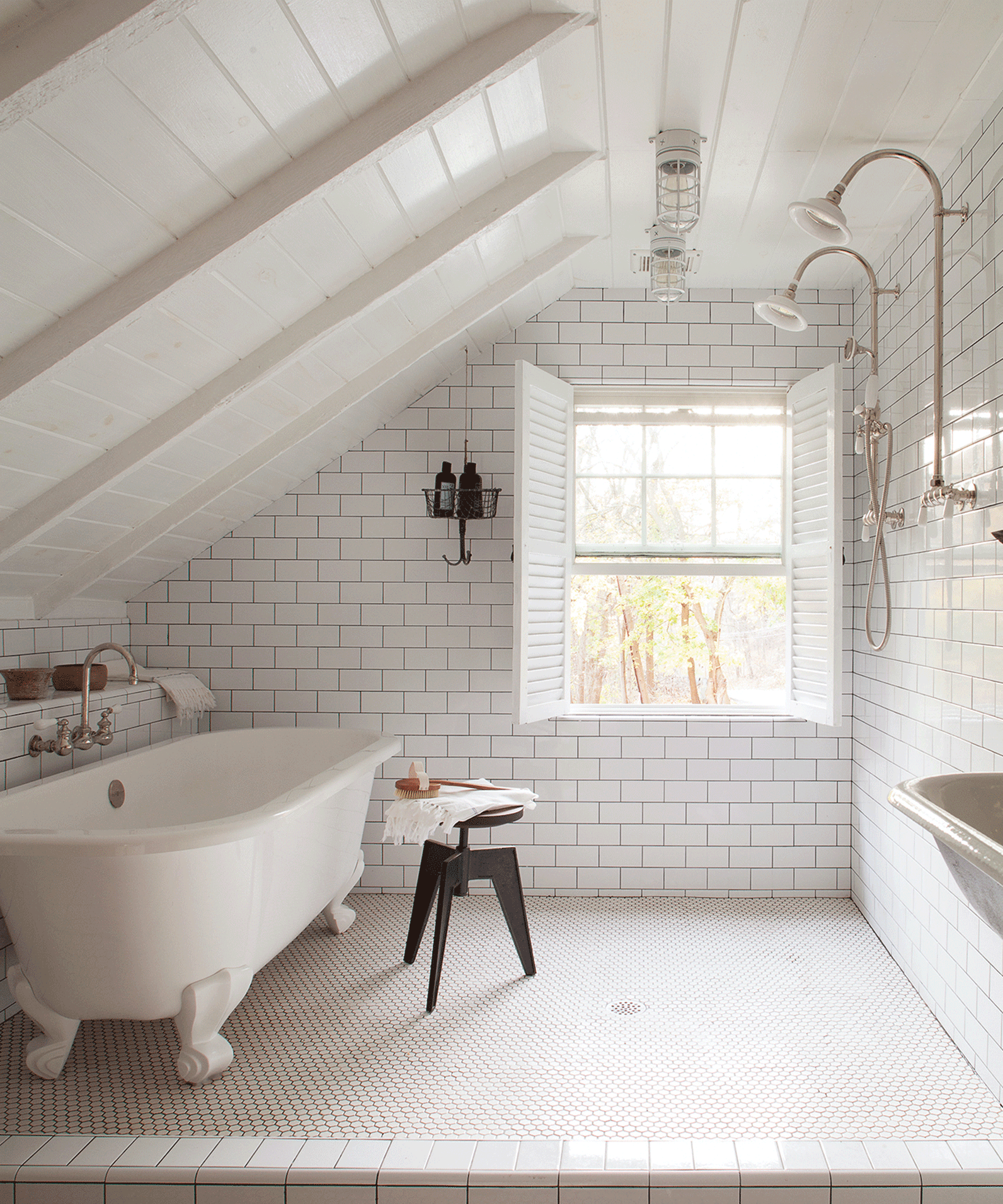
While it’s easiest to install a small wet room in a new-build or extension, any bathroom, upstairs or down, can be fully tanked for wet room use. And a wet room is particularly useful in awkwardly shaped rooms such as sloped rooves or prominent alcoves.
'Wet rooms are particularly effective in small or awkward spaces where head height is limited or there are strange layouts. By choosing this style of shower, it can still provide ample room for a bath, especially under the roof eaves,' says Barrie.
Issues like the direction of floor joists can be problematic but not insurmountable. 'In some cases, you may need to accept a step up into the room, in order to achieve the necessary gradients for efficient water drainage. If it’s done by a good professional, it will be unnoticeable,' adds Nicholas.
16. Create the illusion of a wet room in a standard bathroom
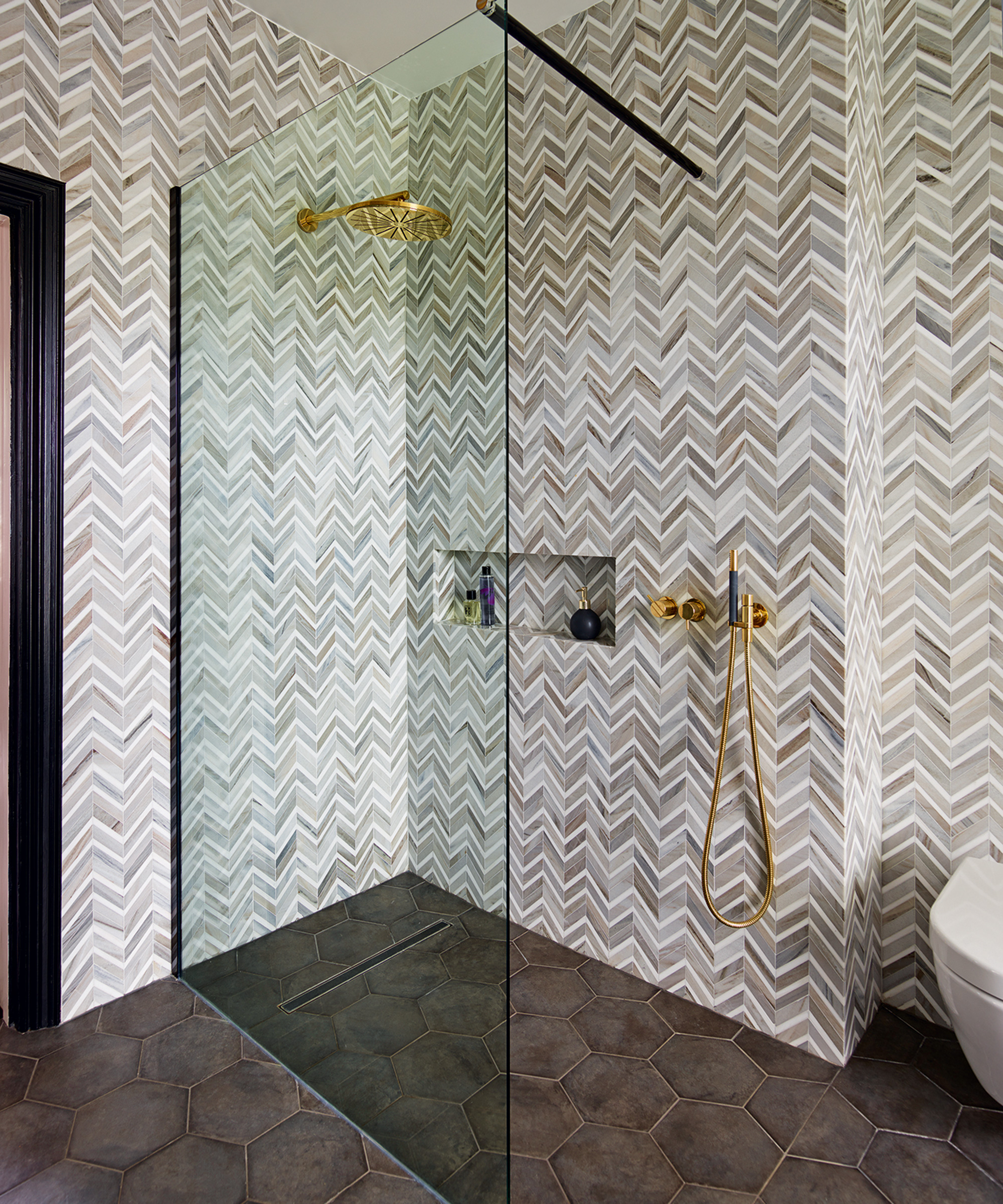
If you are not able to create a true wet room, the latest ultra-low profile shower trays are a clever alternative. A frameless shower enclosure will give any bathroom a modern, seamless feel and create a contained area for showering without the need for a separate cubicle.
Paired with a low-profile shower tray, these walk-in shower ideas with frameless, clear glass panels help to make even the smallest of spaces feel less claustrophobic and therefore a more calming showering experience.
Don’t forget to allow for adequate drainage at the planning stage. Your shower floor ideas may need to be fitted at a sloped angle away from any doors so water can drain away easily. A sunken shower tray that can be installed flush to the rest of the floor.
17. Add interest with patterned tiles
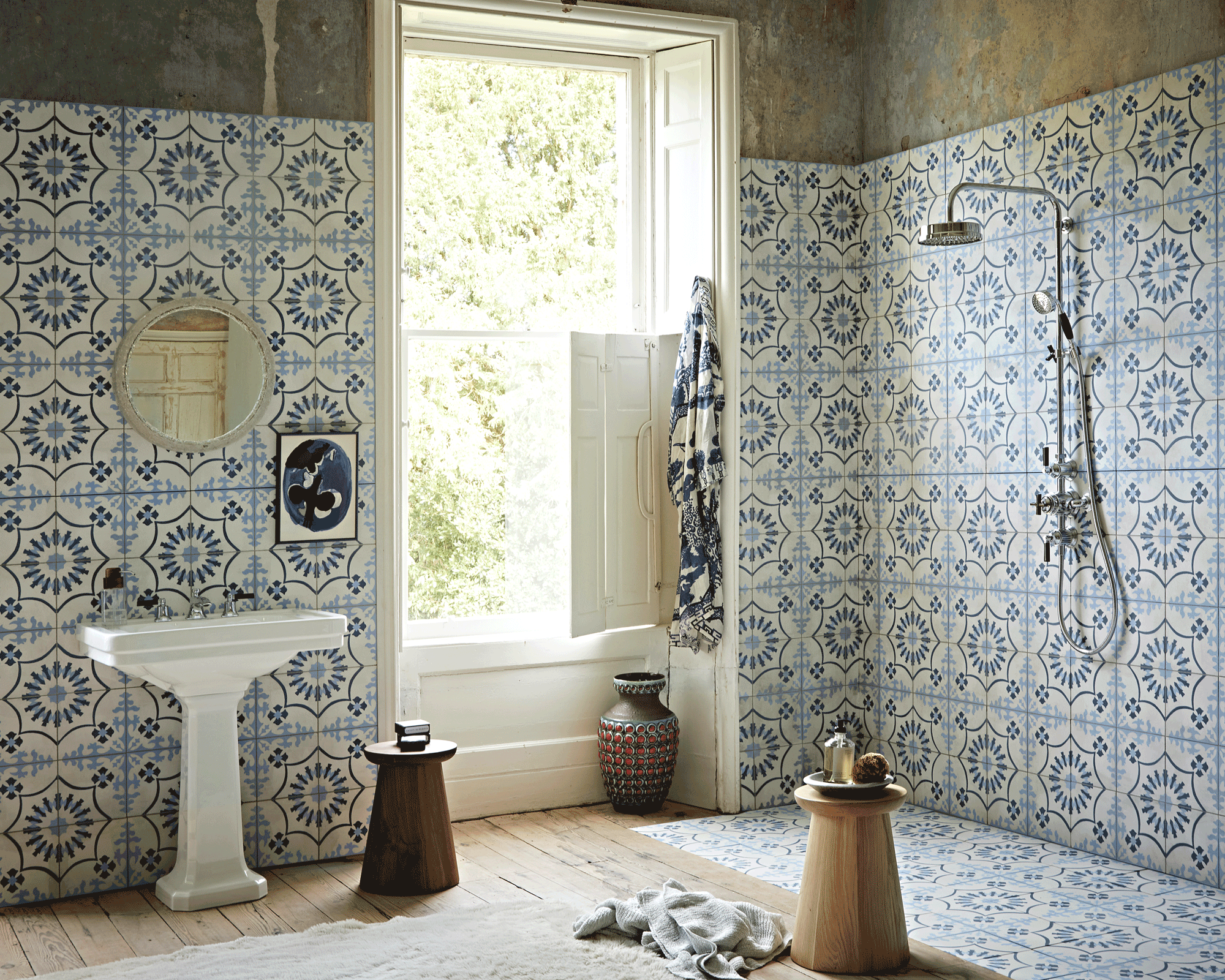
Many wet room designs lean towards a minimalist look but why not introduce color and pattern into the space? Whether your interior design style leans more maximalist or you prefer to infuse boho style, pattern is an easy way to add a playful feature.
In this wet room, a striking blue and white patterned tile has been used on all of the walls and the floor of the shower, creating an eye-catching feature while also creating cohesion throughout the design.
Even in an open plan space you can use a showstopping tile on the shower walls and floor to zone the shower area. If you are feeling even braver you can contrast the tiles you use on the floor and walls for even more impact.
18. Choose the right tile size

Bright and colorful wet rooms make for an invigorating shower experience. Ideal if you're not naturally a morning person. Smaller bathroom tile ideas like mosaics are a great choice for wet rooms, as they’re easy to lay in a slope towards the drainage hole. Alternatively, a mix of metro and patterned tiles creates a cool and contemporary appearance.
Maintain a seamless look by incorporating a recessed shelf within the shower – a great shower storage idea to keep essential bottles without encroaching on the rest of the space.
19. Create a spa-like sanctuary
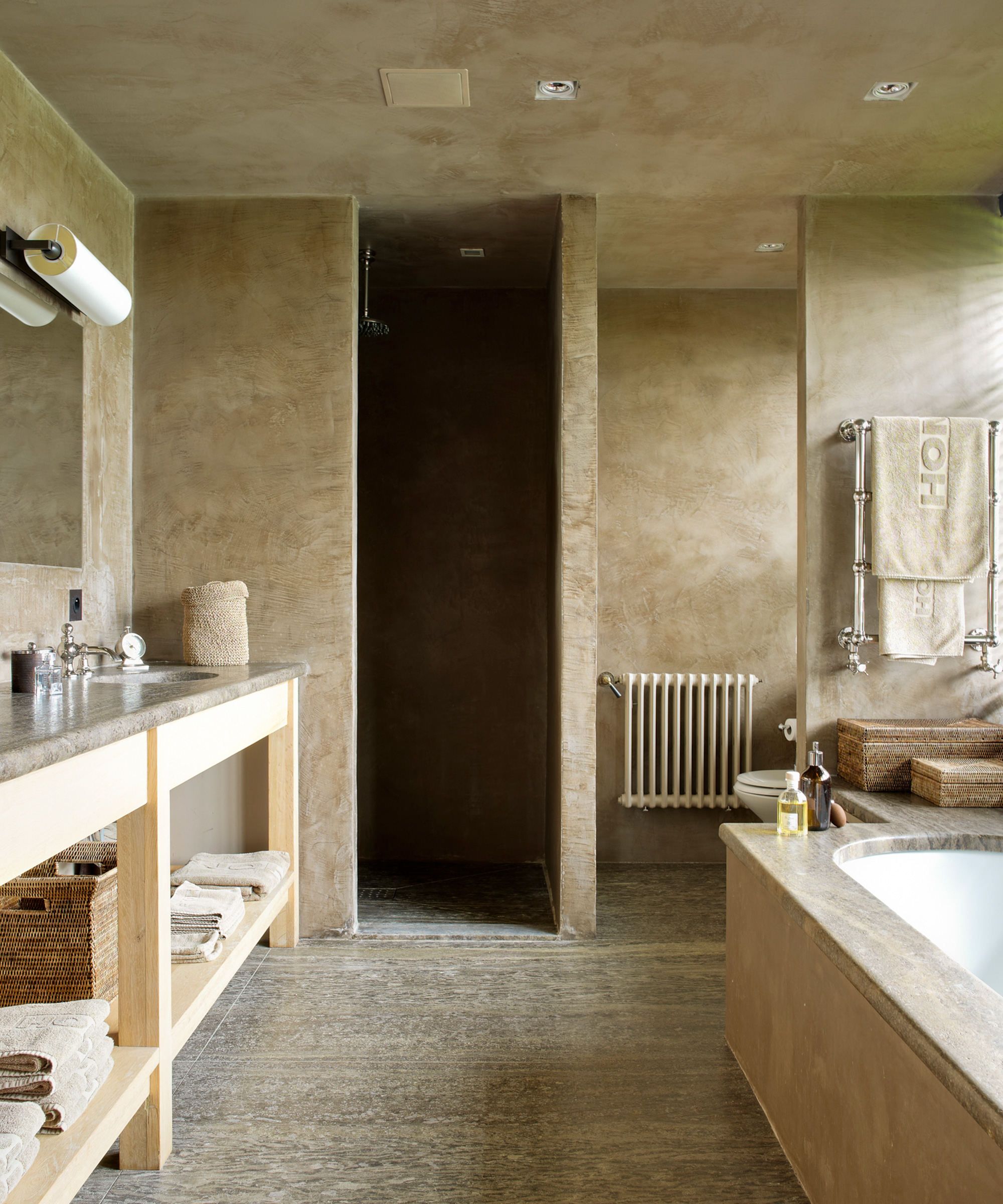
Real estate agents are quick to point out that a family home without a bath will be less saleable, but there are creative wet room ideas with baths you can explore. If space allows, the bathroom can be turned into a spa-like sanctuary with a bath, vanity unit, and smaller wet room-style cubicle.
'Wet rooms give an added level of luxury, allowing a continuous floor finish making a space feel seamless and bigger,' says Gemma Holsgrove, associate director at interior design agency Sims Hilditch. 'With cleverly positioned fittings it can certainly feel well thought through.'
A wet room design can also work alongside a bath, as Sally Cutchie of BC Designs explains. 'Choosing to have a wet room can actually be hugely beneficial when wanting a bath to sit in the same space. As a wet room is fully waterproof it doesn’t need a shower enclosure fitting, which can free up a lot of extra space for the all-important bath.'
20. Integrate a built-in seat in a wet room
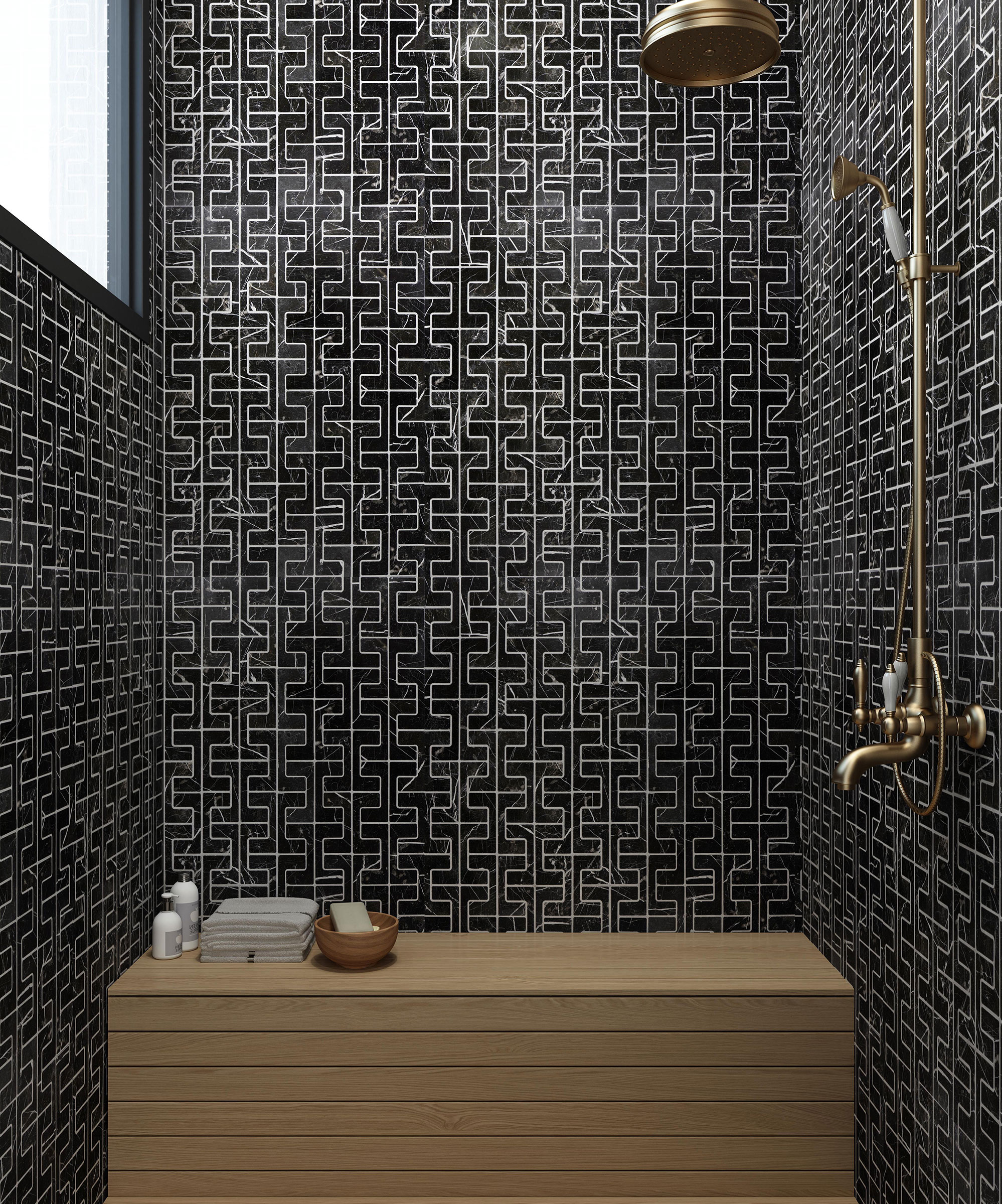
There are so many ways to add luxe appeal to a wet room, but if you want to recreate a spa-style space, add built-in seating for a sauna-like experience. Complete the look with a large rainfall showerhead, then simply sit back and relax.
A wood seat can offer a holistic spa bathroom experience, but you'll need to ensure any timber is treated so that it's suitable for a wet area. Or you can mimic the look with tiles. Just make sure they have a non-slip treatment and are comfortable to sit on.
21. Make sure there is sufficient lighting in your wetroom
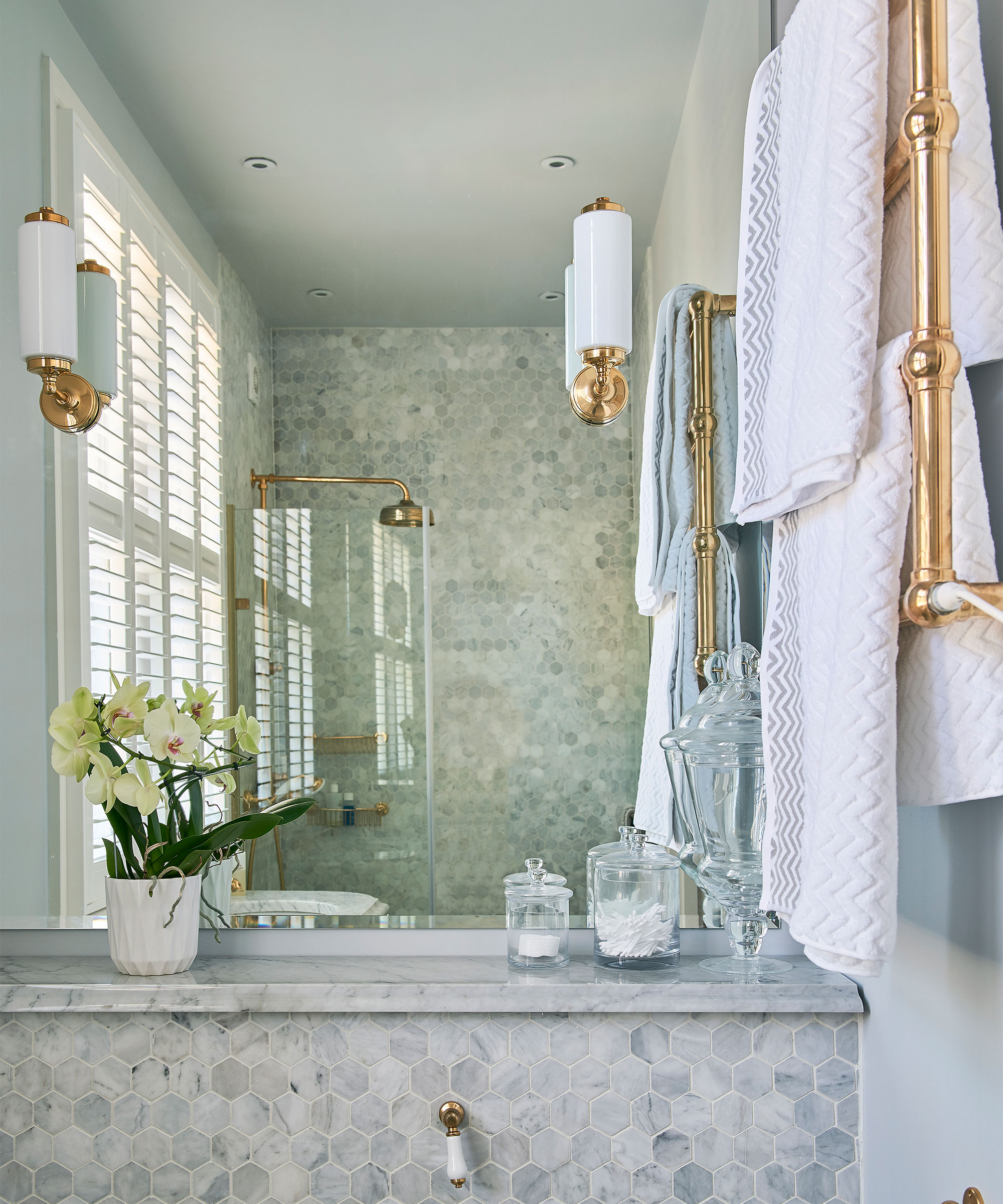
If you are creating a new space for your wet room, you will need to think about light sources during planning. A huge skylight creates the illusion of showering outdoors. So if you've been inspired by trips to tropical climes such as Bali or Thailand, this could be a practical way to recreate that magic.
However, if a skylight isn't an option, you'll need to consider where and how you'll introduce light fixtures. The best bathroom lighting ideas feature at least two lighting circuits – one for overhead lighting and another for adjustable mood and task lighting. Where you place these will depend on any natural light sources, too.
Due to the nature of wet room ideas, you'll need to be really careful with how you're light sources are wired and the fixtures you choose to ensure they are water-tight enough to be located in such a wet environment. Make sure to consult an expert to be on the safe side.
FAQS
Are wet rooms a good idea?
There are lots of benefits to having a wet room – from being able to utilize a small or awkward space where a bath or standard shower enclosure cannot fit, to future-proofing your home.
Estate agents are quick to point out that a family home without a bath will be less saleable. But there are creative options you can explore. For instance, if you have a large master bedroom, consider installing a freestanding, statement tub here for a dash of hotel chic.
'Investing time and money into creating a wet room and properly tanking it can also be incredibly useful when it comes to busy family bath times,' says Paul Bailey, senior category manager at GROHE UK.
The main drawback is the investment and upheaval a wet room project brings, mainly due to the fact that all wet room ideas require proper tanking.
'One other point worth noting is that wet rooms can get quite cold, because there’s no enclosure to keep the steam in,' adds Yousef Mansuri.
How small can a wet room be?
While wet rooms are not limited to incremental sizing, most bathroom designers would recommend that the showering section of a wet room measures a minimum 800 x 800mm.
When planning a shower design for a small bathroom, there are a few aspects which may determine the space required. Will pipework be exposed or concealed? Do you need to install a glass panel to prevent other areas of the room from getting wet?
Don’t forget that adequate ventilation must also be installed in line with building regulations to prevent mold and damp spots.
You can explore more small wet room ideas in our dedicated feature.
What's the best layout for a wet room?
There's no denying that plumbing can limit the layout of a wet room. Basins, baths and showers only have to take away water but, if placed 12ft from an outside wall, the drainage will have to slope gently downwards for quite a long way, avoiding joists, which may not be running in a helpful direction. The sooner an architect or plumber raises a few floorboards, the sooner you’ll know your options.
'In a wet room, the shower area is flush with the floor level and the drain is fitted into the fully tiled floor. Originally wet rooms were completely open without any glass partition. However, a simple fixed glass panel creating a walk-in shower area is a much more practical choice and has become the most popular trend,' advises Rebecca Milnes, designer at CP Hart.
'Wet room systems are not limited to incremental sizing, like shower trays often are, so they are a great solution for awkward or tight spaces.
'In small rooms it is possible to turn the whole area into a walk-in shower. However, it is best to be mindful of the items in the bathroom that need to be kept dry, such as towels and toilet rolls.'
'One of the first things to consider when planning a wet room is where to position the drain. Ideally, the drain should be as far away from the bathroom door as possible, to minimize any risk of water escaping the room.'
'If you have a wooden sub-floor, the way your joists run is crucial to where your drain can be positioned. You’ll also need to think about which way the gradient fall towards the waste will run, to avoid any tricky wedging effects.'
What's the difference between a wet room and a walk-in shower?
‘A true wet room is a fully waterproofed space without a fixed shower door or tray, and usually has an open tiled shower area,’ explains Nicholas.
A walk-in shower, on the other hand, is an area in a bathroom or shower room with a low-level shower tray and glass surround. While completely watertight, you may still wish to include a glass panel in a wet room to contain the water spray.
Is a wet room expensive?
There’s no doubt that a wet room is an investment. The tanking process to ensure the room is completely waterproof can be costly and takes time. All wet room ideas involve tiling the space from floor to ceiling carefully while ensuring proper drainage.
Concealing pipework can also be an investment, though this can often allow recessed shelving and storage to be created as an additional benefit.
You can find out how much it costs to install a wet room in our guide.
There are so many beautiful and inspiring wet room ideas to consider for your own space. Choose a design that fits your interior design style and ensure it works in the space you have. However you choose to create a wet room, you can be sure it will add a sense of luxury to your home.

I’ve worked in the interiors magazine industry for the past five years and joined Homes & Gardens at the beginning of 2024 as the Kitchens & Bathrooms editor. While I love every part of interior design, kitchens and bathrooms are some of the most exciting to design, conceptualize, and write about. There are so many trends, materials, colors, and playful decor elements to explore and experiment with.
- Jennifer EbertEditor